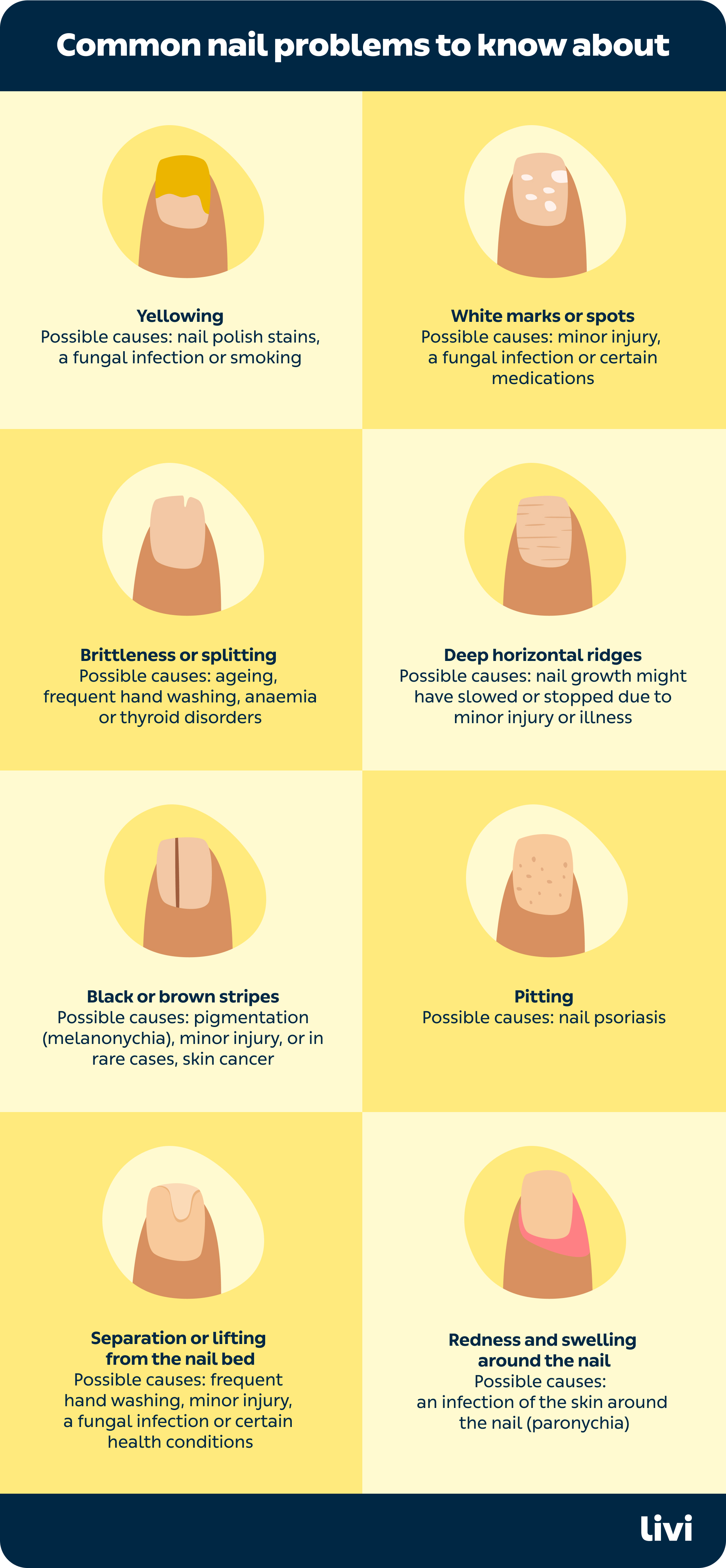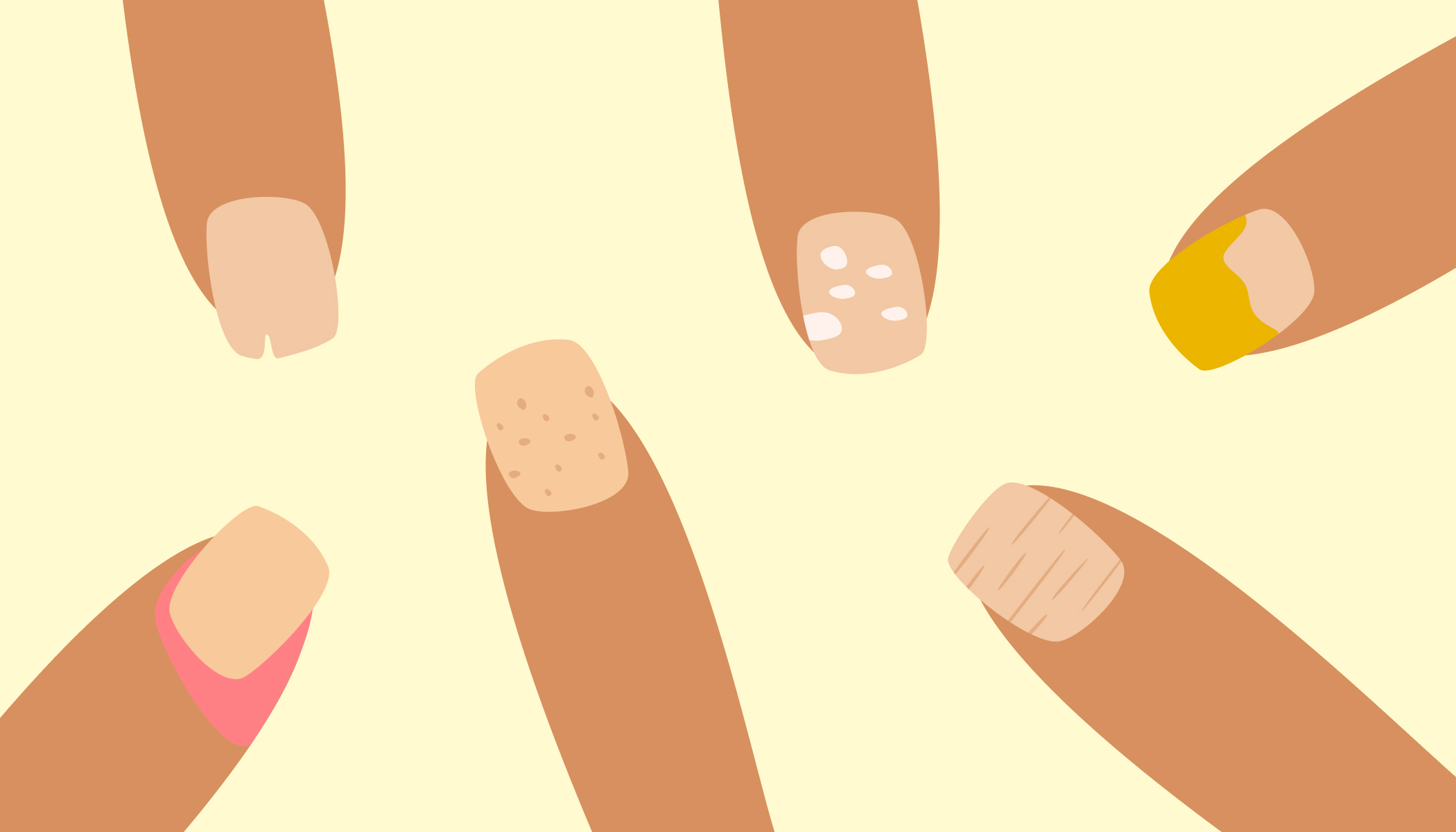Most of us don’t give a lot of thought to our nails. But the condition, shape and colour of your nails could be an indicator of your overall health. Healthy nails are generally even in colour and feel smooth to the touch. As we get older, our nails change. They can become more dull and brittle and grow more slowly.
While most nail changes are completely normal, some can signal health issues. Here’s what to look out for.

1. Your nails have white spots
Small white spots or lines on the nail are most commonly caused by injury or trauma to the nail bed. They will go away as your nail grows out. Common causes include:
- Nail biting and picking
- Manicures or pedicures
- Using acetone nail polish remover
- Accidents where your nail is trapped in a door or window
‘Rarer causes of white spots on the nail may be associated with a fungal nail infection and as a side effect of medication or chemotherapy, ’explains Dr Saloojee.
2. Your nails are yellow
Nail polish often stains nails a subtle yellow. A fungal infection, known as onychomycosis, can also cause yellow nails. This usually affects the toenails, but it can happen to fingernails too. ‘Typically, nail fungus causes the nail to thicken, discolour, split or lift off in some areas,’ says Dr Saloojee. If you think you have a fungal infection, it’s best to speak to a doctor.
‘Yellow discolouration can also be caused by smoking,’ says Dr Saloojee. ‘In rare cases, it may be associated with lung disease, thyroid disease, diabetes or psoriasis.’
To minimise the chance of yellow nails:
- Wash and moisturise your hands and feet regularly
- Change your socks frequently to avoid toenail infections like athlete’s foot
- Wear shoes in public areas like pools or locker rooms
- If you paint your nails, use a base coat under your polish and choose a nail salon that sterilises tools between each customer
3. The skin around your nails is swollen and red
Paronychia is an infection of the skin around your nails. The skin may turn swollen, red, painful and blisters might form.
It usually happens when the skin around the nail is broken, letting bacteria or fungi in. This can happen from biting or picking the skin, manicures, ingrown nails, having your hands in water a lot, or babies sucking their thumb.
Paronychia usually isn’t serious, but in some rare cases the infection can spread and need medical help.
4. Your nails have deep horizontal ridges
Deep grooves or lines that run horizontally across your nail may be a sign that your nail growth has slowed or stopped for a while. This could be caused by a minor injury or illness.
‘Possible causes can include Raynaud’s disease, diabetes, kidney failure, thyroid disease and illnesses that cause a high fever, such as measles, mumps, scarlet fever and pneumonia,’ says Dr Saloojee.
Horizontal ridged lines, also known as Beau’s lines, can also be a sign of a zinc deficiency.
5. Your nails are pitted
Little dents in the surface of your nail, which might look like they’re caused by an ice pick, are called pits. ‘Although pitting can happen for a variety of reasons, it’s often associated with psoriasis, a skin condition that causes red, dry, scaly patches on your elbows, knees and other parts of your body,’ explains Dr Saloojee.
Other symptoms related to nail psoriasis include:
- Brown, yellow or white nail discolouration
- Thickening of the nail
- Changes to the normal shape
- Nails separating from your finger or toe
- Blood under your nail
6. Your nail separates from its nail bed
This condition, known as onycholysis, is a common nail disorder where the nail painlessly lifts from the nail bed. It’s more likely to happen if you have long nails and might be caused by washing your hands a lot or sensitivity to products used during manicures or pedicures.
‘It can also be caused by a fungal infection, certain medications or health conditions, like psoriasis, iron deficiency and thyroid disease,’ explains Dr Saloojee.
If your nails are lifting, Dr Saloojee recommends you:
- Clip the part of the nail that’s separating
- Avoid possible irritants like nail polish
- Use tape to secure the nail to your finger or toe
- Soak your nail in diluted vinegar, which is antimicrobial, to lower your risk of infection
7. Your nail has a brown or black stripe
A dark brown or black stripe along your nail is often due to pigmentation of the nails, known as melanonychia. This is more common in people with darker skin tones.
Splinter haemorrhages can also cause dark lines down your finger or toenails. They might develop after an injury when blood vessels under the nail are damaged and burst.
‘Rarely, but more seriously, a black streak under the nail can be due to melanoma of the nail, which is a type of skin cancer,’ says Dr Saloojee. ‘The dark stripe may widen over time, spreading into the cuticle, and the nail may become painful or bleed.’ Speak to a doctor right away if you notice this.
8. Your nails are brittle
Brittle nails are a common problem that can affect anyone. You may have soft, dry or thin nails that break easily and start to split.
This can be a sign of ageing but can also be caused by long-term exposure to chemicals like nail polish or washing your hands a lot, which can strip your nails of moisture. Other factors that may cause brittle nails include anaemia and thyroid disorders.
How do I keep my nails healthy?
Taking care of your nails is important, not just because it improves the way they look, but because it can help prevent nail health problems.
1. Keep your nails clean and trimmed
Try not to bite, pick or tear your nails or the skin surrounding them.
2. Wear gloves
This will protect your fingernails if you regularly use cleaning products, live in cold climates or your hands are often in water.
3. Eat a healthy diet
Include high-protein foods like fish, meat, pulses and nuts. If you eat a varied diet, you shouldn’t require supplements – but people with weak nails may benefit from a nail supplement that contains biotin, B vitamins, zinc and silica.
4. Be gentle with manicures
Use acetone-free nail polish remover and avoid pushing your cuticles back. This can lead to breaks in the skin around the nail bed and cause infections.
When should I see a doctor?
If you’re concerned about any nail symptoms, and you’ve tried simple remedies that aren’t working, speak to a doctor. It’s a good idea to book an appointment if:
Your nails have changed colour or shape or fallen off and you don’t know why The skin surrounding your nails is red, sore, swollen and warm.
This article was medically reviewed by Dr Roshaan Saloojee, a Livi GP.

